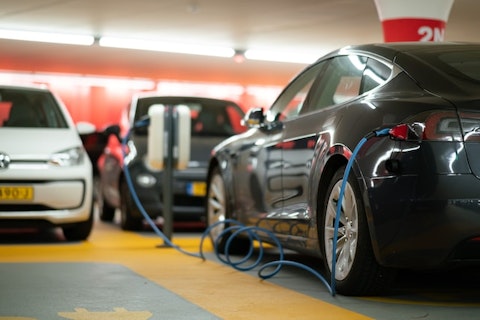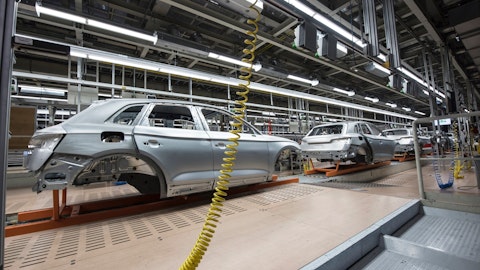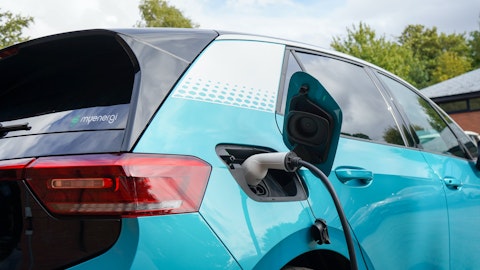Li Auto Inc. (NASDAQ:LI) Q4 2022 Earnings Call Transcript February 27, 2023
Operator: Thank you for standing by, and welcome to the Li Auto Inc. Fourth Quarter and Full-Year 2022 Earnings Conference Call. All participants are in a listen-only mode. There will be a presentation followed by a question-and-answer session. . I would now like to hand the conference over to Ms. Janet Chang, Li Auto IR Director. Please go ahead.
Janet Chang: Thank you, operator. Good evening, and good morning, everyone. Welcome to Li Auto’s fourth quarter and full-year 2022 earnings conference call. The company’s financial and operating results were published in the press release earlier today and are posted on the company’s IR website. On today’s call, we have our Founder, Chairman and CEO, Mr. Xiang Li; and our CFO, Mr. Johnny Tie Li, begin with prepared remarks. Our President, Mr. Donghui Ma and our CTO, Mr. Yan Xie will join for the Q&A discussion. Before I continue, please be reminded that today’s discussion will contain forward-looking statements made under the safe harbor provisions of the U.S. Private Securities Litigation Reform Act of 1995. Forward-looking statements involve inherent risks and uncertainties.
As such, the company’s actual results may be materially different from the views expressed today. Further information regarding risks and uncertainties is included in certain company filings with the U.S. Securities and Exchange Commission and the Hong Kong Stock Exchange. The company does not assume any obligation to update any forward-looking statements, except as required under applicable law. Please also note that Li Auto’s earnings press release and this conference call include discussions of unaudited GAAP financial information as well as unaudited non-GAAP financial measures. Please refer to Li Auto’s disclosure documents on the IR section of our website, which contains a reconciliation of the unaudited non-GAAP measures to comparable GAAP measures.
Our CFO will start the remarks in Chinese for about five minutes. There will be English translation follows after he finished all his remarks. With that, I will now turn the call over to our CEO, Mr. Xiang Li. Please go ahead.
Xiang Li: Hi, everyone, and thank you for joining our call today. 2022 was another year of explosive growth for new energy vehicles in China as more consumers embrace NEVs. According to the China Passenger Car Association, the penetration rate of new energy passenger vehicles reached 31.7% in Q4 2022 compared to 14.8% in 2021 and 29.0% in Q3 2022. Our business continued to grow rapidly. In less than a year, we launched three new models, L9, L8 and L7, fully covering the family SUV market between RMB300,000 and RMB500,000. These launches further solidified our market leadership. In the meantime, we continue to fortify our foundations across R&D, supply chain and sales and service networks. We’ve upgraded our overall business processes and org structure to prepare for ourselves in the one to 10 states.
Next, moving on to deliveries and recent updates. In December 2022, we delivered more than 20,000 vehicles, setting another record not only for ourselves but also all emerging automakers in China, putting us in a very good position for 2023. While these L9 has been dominating the full-size SUV monthly sales chart in China ever since its release in December — sorry, in September, Li L8 continuedly won sales success, becoming the top seller of all large SUVs in December 2022. We delivered 46,319 new vehicles in Q4 2022, and 2022 annual deliveries reached 133,246 units. In December 2022, according to the insurance registration data from Chinese Automotive Technology Research Center, we ranked first in both the SUV and NEV market in the price range of RMB300,000 to RMB500,000, establishing ourselves as one of the go-to brand for all premium SUV shoppers.
Furthermore, in the first quarter, a typical off-season for vehicle sales, we maintained strong order intake, showcasing the competitiveness of our products and services. I would like to hereby thank all of our users and their families for their trust and support along the way. Our revenues reached RMB17.65 billion in Q4 and RMB45.29 billion for the full-year 2022, up 66.2% and 67.7% year-on-year, respectively. With our cost management capability and operational efficiency, we maintained a healthy gross margin of 20.2% and free cash flow of RMB3.26 billion in Q4 2022. Moving on to our product lineup. On February 8, we officially launched the L7, our 5C flagship family SUV with test drive starting the day after. Li L7 features exceptional second row space, a comfortable interior and a long list of standard features.
Equipped with our in-house developed all-wheel drive range extension system, the L7 has a CLPC range of 1,315 kilometers and 0 to 100 kilometers per hour acceleration in 5.3 seconds. L7 is developed with a G rating, the highest cost of rating in the C-IASI 25% small overlap crash test for both the driver and passenger side. It also features the constantly evolved Smart Space infotainment system and our driver assistance system. Li L7 is available in three trim levels, Air, Pro and Max fully covering the RMB300,000 to RMB400,000 price range. Alongside the L7 release, we also released an Air model to our L8 lineup, which succeeded Li L1 in the same segment which covers the RMB300,000 to RMB350,000 price range. We will commence deliveries of Li L7 Pro and Max in early March and delivery of Li L7 Air and L8 Air will start in early April this year.
With the introductions of these new models, we have completed the deployment of L7, L8 and L9 for the entire RMB300,000 to RMB500,000 SUV market. The L7 also allowed us to reach a broader audience base. The L7 not only received raving reviews from customer test drives, but also brought in more diverse family users into our stores, which further led to new leads and orders for the L8. On December 16, the L9 was awarded the Car of the Year in the 10th Xuanyuan Award. It is organized by the Auto Business Review and Austria-based EMS Consulting. The Xuanyuan Award is widely regarded as the Academy award in the Chinese auto industry. With Li L8 and L9 continued strong performance and the addition of L7 to our family, we will set ourselves a stretch goal of 20% market share in the RMB300,000 to RMB500,000 premium SUV segment this year.
Against this backdrop, we expect first quarter deliveries to be in the range of 52,000 to 55,000 units. Next on to supply chain. Despite continued supply chain challenges, our deliveries for both L9 and L8 exceeded 10,000 units in the first full month of delivery. This was only possible with the support of our suppliers, and this was also a testament to our solid supply chain management capabilities. We remain confident of our parts supply in 2023 as we further improve our planning, risk management and cost management capabilities to cope with potential challenges and risks. We take a modularized approach to supply chain management. While we work closely with our supplier base, we have also strategically identified core area for in-house development and vertical integration in order to strike a good balance between cost and risk.

Photo by Michael Fousert on Unsplash
Over the past three years, we have been deploying a series of manufacturing facilities and the range extender in electric drive unit. Let’s move on to the sales network. In Q4 2022, we continue to strengthen our direct sales and services network and to increase our user outreach and brand awareness in order to bolster our commercial capabilities and drive growth. As of January 31, 2023, we operated 296 retail stores, covering 123 cities as well as 320 service centers and Li Auto authorized body shops in 222 cities. In 2022, we expand — while expanding our sales networks, we focused on upgrading our existing retail stores to house multiple models in order to reach more different types of families. In the coming quarters, as our brand continues to gain momentum, we have more multi-function stores — we will have more multi-function stores in our sales network.
After more than three years of operation, the direct sales model has proven to provide better user experience and at a lower cost, which will remain our long-term commitment as the premium car brand. In 2022, our SG&A expenses already lower than our R&D expenses, and we expect to further reduce our selling expenses as a percentage of revenue in 2023. In terms of R&D, it has always been a cornerstone of our value creation process for family users. Excellent user research and development capabilities have not only allowed us to stand out in the NEV market, but also will ultimately allow us to emerge as a world-class tech company. In 2022, we made great strides in research and development. On the electric drive unit, our L-series vehicles are powered by our in-house all new range extension 2.0 system with our 1.5-liter four cylinder turbocharged engine, boasting a maximum thermal efficiency of 40.5% and coupled with our proprietary five-in-one drive unit has significantly enhanced their overall noise vibration harshness performance.
Supported by our proprietary hardware and software, the Li Magic Carpet air suspension provides top-notch ride and handling and in particular, our own XCU vehicle controller is capable of handling complex vehicle information at high speed, enabling millisecond grade vehicle control. Our smart space continues to evolve. Li Xiang Tong Xue for instance, has evolved with a new generation device cloud integrated architecture and has been rolled out to all of our L-Series model. Featuring our in-house inference engine for in-car scenario, LisaRT, it provides solid foundation for the in-car deployment of more powerful and complex algorithms. Moreover, we have made remarkable progress in the voice and vision-based interaction algorithms. On the speech side, with our innovative MIMO-NET algorithm that can accurately isolate different human voices in multiple zones.
We have voice recognition algorithm, MSE-NET, Li Xiang Tong Xue’s activation and recognition accuracy both reached 98% in real-world testing. These rates remain at over 90% in various demanding scenarios, including high noise, low voices and children’s voice. On the vision side, our MVS-net algorithm can accurately recognize gestures of all occupants, combined with innovative gesture technology and makes interactions through gestures easier and more natural, allowing a whole family to enjoy the superpower of making contact and taking control over the air. In terms of autonomous driving, we adopted the fusion BEV algorithm framework jointly proposed by Tsinghua University, MIT, and us, which can be flexibly deployed with Li AD Max and AD Pro’s different hardware configuration.
Our in-house highway NOA prediction algorithm enables organic automated lane change and a smooth acceleration and deceleration experience. As of now, over 220,000 family users have used our highway NOA features, covering 100 million kilometers of distance. During the 2023 Chinese New Year holiday alone, our highway NOA mileage of all models reached almost 8 million kilometers. This year, we’ll further expand our NOA features into urban driving scenarios with beta testing for early bird users planning on Li AD Max in the first quarter of this year. In addition, we created the industry’s first AEB function with LiDAR applications on Li AD Max and extended the LiDAR’s algorithms’ safety scenarios for major traffic participants, such as vehicles, cyclists, and pedestrians to cover irregular scenarios, including special vehicles as well as night driving scenes.
Going forward, we will continue to focus on developing our core EREV and BEV technologies in-house and further elevating our product level intelligence. To that end, we will consistently direct our R&D resources across products, platforms, and systems to fuel our long-term growth. In summary, we view our long-term success as a function of our continued investment in R&D and our business capabilities, which will support the creation of more hit model, enhance our brand value and serve as critical pillars of our business flywheel. 2023 will be another year of rapid development of the NEV industry and for Li Auto in particular. We have full confidence that we will be able to build an increasingly innovative and diverse model lineup and deliver outstanding products and services that will continue to exceed our users’ needs.
With that, I will turn over the call to CFO — our CFO, Johnny, for a deep dive into our financial performance.
Tie Li: Thank you, Li Xiang. Hello, everyone. I will now review some of our 2022 fourth quarter financials. To leave more time for the Q&A session, I will drive financial highlights here and encourage you to refer to our earnings press release for more details. Our total revenues in the fourth quarter of 2022 were RMB17.65 billion or $2.56 billion, representing an increase of 66.2% year-over-year and an increase of 88.9% quarter-over-quarter. This included RMB17.27 billion or $2.5 billion from vehicle sales, which was up 66.4% year-over-year and 90.9% quarter-over-quarter. The increase was mainly attributable to the increase in vehicle deliveries as well as higher average selling price due to our delivery of the Li L9 starting in late August and Li L8 starting in November.
Revenues from other sales and revenues were RMB381.5 million or $55.3 million in the fourth quarter, representing an increase of 55.9% year-over-year and an increase of 28.7% quarter-over-quarter. The increase was mainly due to the increased sales of accessory and services in line with higher accumulated vehicle sales. Our cost of sales in the fourth quarter was RMB14.08 billion or $2.04 billion, representing an increase of 70.9% year-over-year, an increase of 72.6% quarter-over-quarter. Our gross profit in the fourth quarter of 2022 was RMB3.57 billion or $517.1 million, growing 49.8% compared with the fourth quarter of last year and 201.7% compared with the third quarter of this year — of 2022. Our vehicle margin in the fourth quarter of 2022 was 20% compared with 22.3% in the fourth quarter of 2021 and 12% in the third quarter of 2022.
The decrease in vehicle margin over the fourth quarter of 2021 was mainly due to the different product mix between the two quarters. The increase in vehicle margin over the third quarter was mainly attributable to the losses on purchase commitments related to Li ONE in the third quarter of 2022. Gross margin in the fourth quarter of 2022 was 20.2% compared with 22.4% in the fourth quarter of 2021 and 12.7% in the third quarter of 2022. Operating expenses in the fourth quarter of 2022 were RMB3.7 billion or $536.4 million, representing an increase of 47.1% year-over-year and an increase of 11.7% quarter-over-quarter. R&D expenses in the fourth quarter of 2022 were RMB2.07 billion or $300.1 million, up 68.3% year-over-year and 14.7% quarter-over-quarter.
The increase was primarily driven by increased expenses to support our expanding product portfolios as well as increased employee compensation as a result of our growing number of staff. Our selling, general, and administrative expenses in the fourth quarter of 2022 were RMB1.63 billion or $236.3 million, representing an increase of 44.8% year-over-year, an increase of 8.1% quarter-over-quarter. The increase was primarily driven by increased employee compensation as a result of our growing number of staffs as well as increased rental expenses associated with the expansion of our sales and servicing network. Loss from operations in the fourth quarter of 2022 was RMB133.6 million or $19.4 million compared with RMB24.1 million — from operations in the fourth quarter of 2021 and representing a decrease of 93.7% from RMB2.13 billion loss from operations in the third quarter of 2022.
Net income in the fourth quarter of 2022 was RMB265.3 million or USD38.5 million, representing a decrease of 10.2% from RMB295.5 million net income for the same period in 2021 and compared with RMB1.65 billion net loss in the third quarter of 2022. Turning to our balance sheet and cash flow. Our balance of cash and cash equivalents, restricted cash, time deposit, and short-term investment was RMB58.45 billion or $8.47 billion as of December 31, 2022. Net cash provided by operating activities in the fourth quarter of 2022 was RMB4.93 billion or $714.1 million. Free cash flow was RMB3.26 billion or $472.3 million in the fourth quarter of 2022. As of December 31, 2022, we had a total of 19,396 employees. For more of our 2022 full-year financials, please refer to our earnings press release for more details.
And now for our business outlook. For the first quarter of 2023, the company expects the deliveries to be between 52,000 and 55,000 vehicles, representing an increase of 64% to 73.4% from the first quarter of 2022. The company also expects first quarter total revenues to be between RMB17.45 billion and RMB18.45 billion or $2.53 billion and $2.68 billion, representing an increase of 82.5% to 93% from the first quarter of 2022. This business outlook assumes supportive macroeconomic conditions, no significant disruption in the supply chain and reflects the company’s current and preliminary view on its business situation and market conditions, which is subject to change. I will now turn the call over to the operator to start our Q&A session. Thank you.
See also 11 Most Undervalued Biotech Stocks and George Soros’ Top 15 Holdings.
Q&A Session
Follow Li Auto Inc. (NASDAQ:LI)
Follow Li Auto Inc. (NASDAQ:LI)
Operator: Thank you. . The first question today comes from Tim Hsiao with Morgan Stanley. Please go ahead.
Tim Hsiao: So my first question is about the global outlook. We noticed that previously the management shared the monthly deliveries could, at least, reach 25,000 after the delivery of L7 started with a further point to 30,000 after the air versions of L7, L8 are available. So I just want to double confirms that how we come up with such as drawn target? Are they based on the pace of the new order and tech order backlog? Or our assessment of total addressable market of five, six seaters SUV? And how fast could Li-MOS deliveries reached and stabilize at such level? And more importantly, could the supply chain coordinately ramp up their output at a such rapid pace?
Xiang Li: So 25,000 to 30,000 orders is our internal goal. And we expect to reach this level in Q2. This is — April is the first full month where we deliver the L7 Pro and Max. And May will be the first month where we deliver the Air version of L7 and L8. Second question about our ramp-up. Admittedly, we experienced some issues in the second half of 2022 with our deliveries. And we attributed really to two things. One is because we had set a very aggressive delivery goal because we were seeing really good order intake. So that plays a lot of pressure on the supply chain. And the second cause was we were switching from a single model to multiple models, which again, plays a lot of pressure on our sales and service networks.
So across Q4 and Q1 of this year, we have been going through a long process of upgrading our sales and service and manufacturing systems so that now we have a very robust system all the way from planning to delivery, to manufacturing and sales so that we can handle really the stress that comes in with our strong order intake. And that really helps us to make three things a lot better. The first one is resource allocation. We could really allocate the best resource to where it’s most needed. And the second one is our employees will feel more fulfilled as they achieve these goals and certain that it also applied suppliers to reach higher efficiency on their side.
Tim Hsiao: So my second question is about battery procurement costs and the potential impact to your margin. We so strong likely see that battery prices, which continued a downtrend this year. And previously, local media also reported, like and likely others are rolling to offer some aggressive pricing in exchange for long-term contracts from Li Auto’s and other top notch TV makers. So could the management team comment on potential collaboration with battery makers? And how should we think about the contribution to Li Auto’s margin improvement in the following quarters in terms of scale and timing versus current logo?
Xiang Li: So in terms of battery pricing, there are many factors at play, including the Li mines and battery pricing mechanisms. But in general, our belief is that as battery costs continues to approach a more reasonable level, we think it’s good for the industry, not only for us, as OEMs, but also for suppliers and battery manufacturers. So as we expand to more models and as our sales continue to ramp-up, we believe battery is a very strategic asset and we will continue to commit to a multi-supplier strategy for two reasons. One is for not only for the stability of our supply chain, but also to meet the time requirements for developing multiple models at the same time. Now in the long-term, we believe that battery prices will continue to move towards a more reasonable level.



